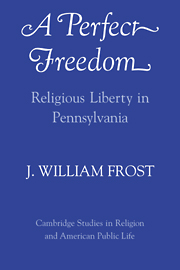Book contents
- Frontmatter
- Contents
- Acknowledgments
- Preface to This Paperback Reissue
- Introduction: The Pennsylvania Traditions of Religious Liberty
- I The Creation of Religious Liberty in Early Pennsylvania
- II Pacifism and Religious Liberty
- III The Clergy and Religious Liberty
- IV Religious Liberty in the Revolution
- V Religious Liberty and the Republic
- VI Politicians Debate Religious Liberty
- VII The Churches and Religious Liberty
- VIII The Legal Implications of Religious Liberty
- IX Religious Liberty and the Catholic and Jewish Minorities
- Epilogue: The Dismantling
- Notes
- Bibliography
- Index
I - The Creation of Religious Liberty in Early Pennsylvania
- Frontmatter
- Contents
- Acknowledgments
- Preface to This Paperback Reissue
- Introduction: The Pennsylvania Traditions of Religious Liberty
- I The Creation of Religious Liberty in Early Pennsylvania
- II Pacifism and Religious Liberty
- III The Clergy and Religious Liberty
- IV Religious Liberty in the Revolution
- V Religious Liberty and the Republic
- VI Politicians Debate Religious Liberty
- VII The Churches and Religious Liberty
- VIII The Legal Implications of Religious Liberty
- IX Religious Liberty and the Catholic and Jewish Minorities
- Epilogue: The Dismantling
- Notes
- Bibliography
- Index
Summary
William Penn is commonly ranked among the heroes of American history for his contribution to religious freedom. Such an emphasis is eminently justified, for, as one historian recently argued, a consistent political theme in Penn's life was his opposition to persecution for religion and attempts to gain toleration. The story of Pennsylvania begins with the early Quakers' struggle against persecution in England. In the 1670s Penn's efforts to transform that struggle politically and intellectually bore fruit in the Frame of Government and early laws of Pennsylvania. Penn only began the process, for the initial history of religious freedom in the colony is a convoluted story, which involved the proprietor, the English government, Quaker settlers, and adherents of other faiths.
The experiment in Pennsylvania shows that implementing religious liberty required complicated adjustments in ideas and institutions: the rights of a religious majority and minorities, the limits of moral legislation, the property rights of churches, the privileges of the clergy, and the relations among denominations. The theme of this chapter is that while Penn initiated the move toward religious freedom, circumstances as well as ideology created the final pattern.
In England before 1660 the Quaker demand for an end to persecution rested upon the belief that the focus or seat of religion came from the conscience. True religion was very much an inward, though not a subjective, matter. God only was Lord of conscience and to erect any external authority in this sphere would be to subject God to a lesser entity.
- Type
- Chapter
- Information
- A Perfect FreedomReligious Liberty in Pennsylvania, pp. 10 - 28Publisher: Cambridge University PressPrint publication year: 1990



